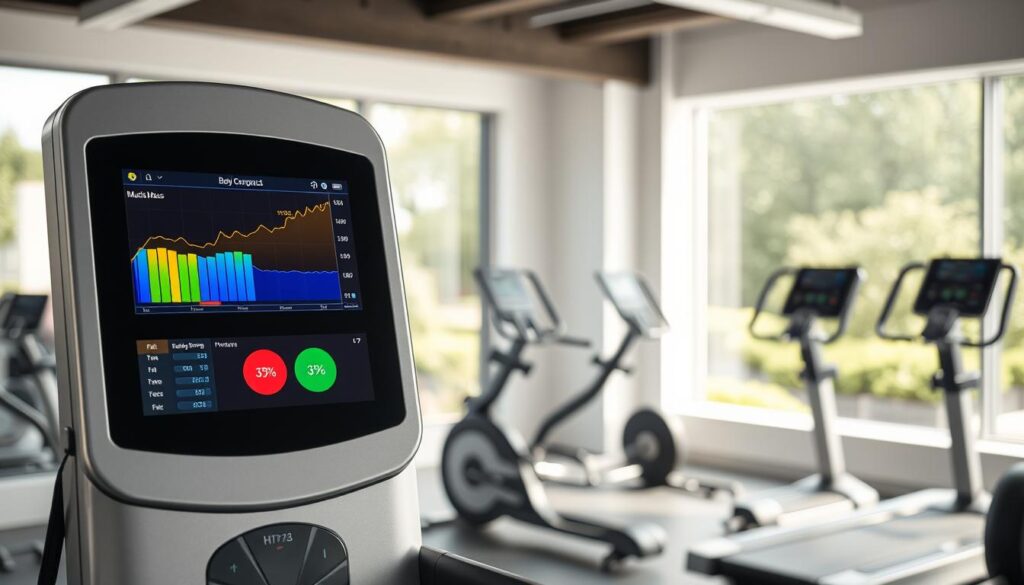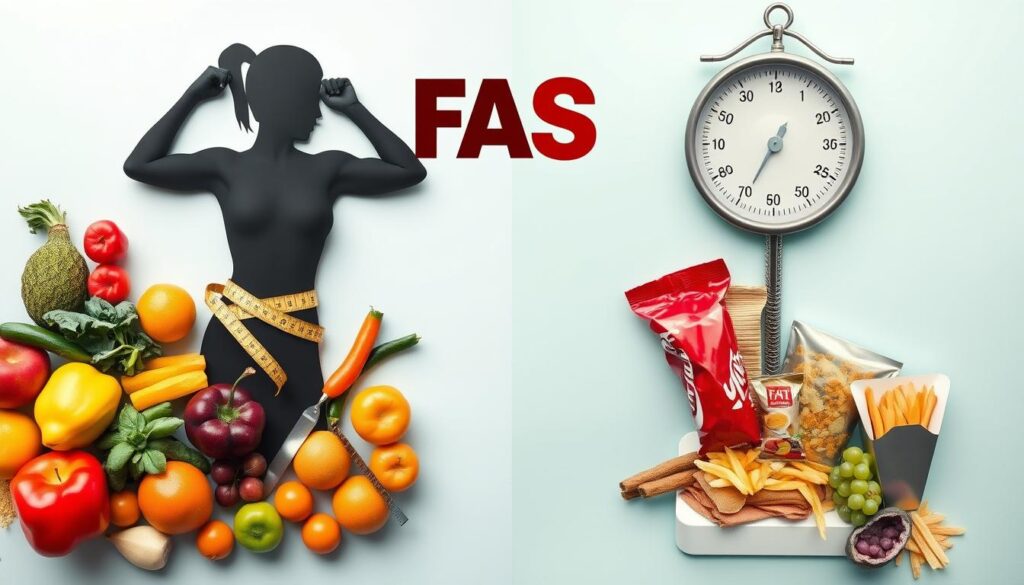Starting your health and fitness journey is exciting. But, it’s key to know the difference between losing fat and losing weight. Losing weight means you’re losing fat, muscle, and water. Losing fat means you’re just losing extra fat.
This difference matters a lot. It affects how well you feel, how you move, and how long your results last. By knowing this, you can choose the best way to reach your fitness goals.
Key Takeaways
- Weight loss means losing fat, muscle, and water. Fat loss means just losing extra fat.
- Knowing the difference helps you reach your health and fitness goals better.
- Changing your body composition, like keeping muscle, is very important. It affects your health, how well you move, and how long your results last.
- Measuring your body fat percentage is key to seeing how much fat you’ve lost.
- Choosing to lose fat over weight can lead to better long-term health and happiness.
Understanding the Fundamental Difference Between Fat Loss and Weight Loss
Knowing the difference between fat loss and weight loss is key. They both might make the scale go down. But they affect your body in very different ways.
What Constitutes Weight Loss
Weight loss means losing any part of your body. This includes muscle, bone, water, and organs. Losing muscle and bone can make you weaker and less energetic.
Defining Fat Loss
Fat loss is about losing body fat. It keeps your muscle and bone strong. This makes you look leaner and more toned.
Why the Distinction Matters
Fast weight loss can hurt your body. It can make you lose muscle and bone. This can slow down your metabolism and affect your mood.
Women naturally have more body fat than men. A healthy body fat percentage for women is 20% to 30%. For men, it’s 10% to 20%. Knowing this helps set better goals for success.
“Understanding the distinction between weight loss and fat loss is crucial for embarking on a transformative wellness journey prioritizing long-term health and vitality.”
The Science Behind Body Composition Changes
It’s important to know how metabolism, muscle, and fat work together. Your diet, exercise, hormones, and genes all play a part. They help you reach your body goals.
Muscle is key for burning calories when you’re not moving. The more muscle you have, the more calories you burn. Less muscle means a slower metabolism and harder fat loss.
Fat storage depends on calories, hormones, and how active you are. Eating more calories than you need leads to fat storage. Hormones like insulin and cortisol affect how fat is stored.
Knowing how these work helps you lose fat and keep muscle. This is important for lasting weight control.
“Approximately 25% of weight loss is estimated to be lean tissue (ΔFFM/ΔWeight = ~0.25), with the rest being fat mass.”
Not all weight loss is good. Losing too much weight too fast can harm your health. You should aim to lose fat while keeping or growing muscle.
With the right diet and exercise, you can lose fat without losing muscle. This leads to a healthier, lasting change.
Why Losing Fat vs Weight Matters for Long-term Health
Losing fat is better than just losing weight. The scale might go down, but what matters is what you lose. Losing fat helps your health and fitness more than losing weight.
Impact on Metabolic Health
Losing fat lowers your risk of diseases like heart disease and diabetes. Keeping muscle while losing fat makes your body work better. It helps control blood sugar and keeps your heart healthy.
It also helps your bones stay strong as you get older. This is very important.
Effects on Physical Performance
Keeping muscle while losing fat makes you stronger and more active. You’ll be able to keep losing weight for a long time. This means you can stay fit and healthy for years.
Long-term Sustainability
Trying to lose fat is better for keeping weight off. Quick weight loss often comes back. But losing fat and keeping muscle makes your body healthier. This helps you reach your fitness goals for good.
“Sustainable, healthy behaviors are crucial for maintaining weight loss and achieving long-term success.”
Measuring Progress: Beyond the Scale
The scale is not the only way to measure your health and fitness. It shows your body weight, but not everything. To see how you’re really doing, look at other ways to measure your body.
Tracking your body fat percentage is a good idea. You can use a body fat scale. It sends a small electrical current through your body. This helps figure out your body’s water, muscle, and fat.
Also, check your waist-to-hip ratio. This shows how your body fat is spread out. A good ratio is below 0.85 for women and 0.90 for men.
Progress photos are very helpful too. Taking pictures of yourself often shows changes in your body. These changes might not show up on the scale right away.
Don’t forget about body measurements. Measuring your waist, hips, arms, and more shows fat loss. Even if the scale doesn’t change, you can still see progress.
Using these methods helps you understand your body’s changes better. You can celebrate the victories that aren’t just about the scale.

“The scale can be a useful tool, but it doesn’t tell the whole story. Focusing on body composition changes, rather than just weight, is the key to long-term success.”
The Role of Protein in Preserving Muscle Mass
When you start losing fat, keeping your muscle is key. Protein helps a lot with this. It helps make new muscle and keeps your body lean when you eat fewer calories.
Optimal Protein Intake Guidelines
Experts say you should eat 0.8 to 1.1 grams of protein for every pound of your body weight. This gives your muscles the amino acids they need. It helps with muscle synthesis and keeps your lean body mass when you lose weight.
Timing Your Protein Consumption
When you eat protein matters a lot. Eating it around your workouts helps your muscles grow. Try to eat a good protein source 30 minutes before and after your workouts.
Best Protein Sources
- Lean meats (e.g., chicken, turkey, lean beef)
- Fish and seafood
- Eggs and dairy products
- Plant-based options like legumes, soy, and quinoa
Eating different types of protein helps your body build and keep lean muscle. This is important when you’re losing fat.
“Adequate protein intake, combined with resistance training, helps preserve lean body mass during calorie restriction, supporting more effective fat loss.”
Exercise Strategies for Fat Loss
To lose fat, you need a mix of exercises. Resistance training keeps your muscles strong. It also helps your body burn more calories. High-intensity interval training (HIIT) burns lots of calories and boosts your metabolism.
Here’s what you should do to lose fat:
- Resistance Training: Do strength exercises for all big muscles 2-3 times a week. This keeps or grows your muscle, helping you burn more calories when you’re not working out.
- HIIT Workouts: Do short, hard workouts followed by rest. This burns a lot of calories and makes you fitter. Try to do 2-3 HIIT workouts a week.
- Steady-State Cardio: Do 150-300 minutes of moderate or 75-150 minutes of hard aerobic activity weekly. This helps you burn calories and keeps your heart healthy.
“Losing weight means eating fewer calories or burning more through exercise. The National Institute of Health says to eat 500–1000 calories less and lose 1–2 pounds a week.”
By mixing resistance training, HIIT, and steady cardio, you’ll lose fat better. You’ll also keep your muscles strong and stay healthy.

Creating a Sustainable Caloric Deficit
To lose fat in a healthy way, you need to find the right balance. Eating 500-600 calories less each day can help. Use your age, gender, weight, height, and how active you are to figure out how many calories you should eat.
Calculating Your Daily Needs
First, find out your basal metabolic rate (BMR). This tells you how many calories you burn when you’re not moving. Then, add how active you are to get your total daily energy expenditure (TDEE). This number is the base for your calorie deficit.
Adjusting Macronutrients
When changing what you eat, eat more protein to keep your muscles strong. Don’t change your fat intake too much. Adjust your carbohydrate intake based on how active you are. Eat lots of fruits, veggies, lean proteins, and healthy fats. Try to eat less processed foods and sugar.
Keep an eye on how many calories and nutrients you’re getting. Make changes as needed to keep losing fat. A steady, smart plan is the best way to keep losing weight for good.
| Macronutrient | Recommended Intake for Fat Loss |
|---|---|
| Protein | 1.6-2.2 g per kg of body weight |
| Fat | 20-30% of total daily calories |
| Carbohydrates | Remaining calories, adjusted based on activity levels |
Common Mistakes in Fat Loss Journey
Starting a fat loss journey is rewarding but comes with challenges. Stay away from these common mistakes to get lasting results and keep your health.
Crash Diets and Muscle Loss
Crash diets with too little food can cause muscle loss. This is bad for losing fat. Aim for a small calorie cut and do strength training to keep muscle.
Overtraining and Fatigue
Doing too much exercise and not resting enough can make you tired. It also raises your chance of getting hurt and slows down fat loss. Listen to your body and make sure to rest and recover well.
Neglecting Sleep and Stress Management
Not enough sleep and too much stress can harm your hormones and metabolism. Try to sleep 7-9 hours each night. Also, use stress-reducing activities like meditation or deep breathing.
Remember, losing fat is a long-term journey, not a quick race. Stay away from fast fixes and focus on building lasting habits. Being consistent, patient, and taking care of yourself will help you succeed.
| Common Mistake | Consequence | Recommended Solution |
|---|---|---|
| Crash diets | Muscle loss, metabolic slowdown | Moderate calorie deficit, strength training |
| Overtraining | Fatigue, increased injury risk | Balanced workout routine, adequate rest |
| Inadequate sleep | Hormonal imbalance, impaired metabolism | 7-9 hours of quality sleep per night |
| High stress levels | Increased cortisol, potential fat storage | Stress management techniques, such as meditation |
Avoid these mistakes and make balanced, lasting changes. This will help you reach your fat loss goals.
“The secret of getting ahead is getting started. The secret of getting started is breaking your complex overwhelming tasks into small manageable tasks, and then starting on the first one.” – Mark Twain
Special Considerations for Different Age Groups
Your age affects how you lose fat. As you get older, your body changes. You need different ways to reach your goals.
Young people have a fast metabolism. They can start healthy habits early. But, as you get older, your metabolism slows down. You need to pay more attention to what you eat and exercise.
Older adults need to keep their muscles strong. This helps fight off muscle loss. Eating enough protein and doing strength exercises is important. No matter your age, finding the right plan for you is key.

